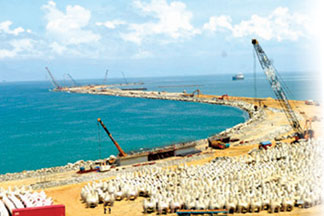|
CSH to retain transshipment hub status:
Bright future for shipping industry
By Sanjeevi Jayasuriya
The new Colombo South Harbour (CSH) which will facilitate an
additional capacity of 7.2 million TEUs was opened for business
recently. This facility will enable Sri Lanka to regain its role as a
leading South Asia transshipment hub.
 |
|
The CSH breakwater
which has now been completed. |
The Colombo port can now accept the largest generation of 18,000,
20-foot equivalent units (TEUs) container ships and has the facility to
move goods faster and more cost efficiently compared to other ports in
the region, with a new breakwater, deeper basin and the first of three
modern new terminals to be opened, Colombo Shippers Academy, Chief
Executive Officer, Rohan Masakorala told Sunday Observer Business.
Excerpts of the interview:
The local shipping industry will have a promising future with the new
facility.
The port which was opened in 1912 was designed for small ships. Over
a period of time birthing capacity reached saturation point where no
further expansion was possible.
The port was expanded to attract large ships to achieve economies of
scale. This changed the maritime demand for ships. Due to the expansion,
shippers and the Colombo Port can now attract large triple E class
vessels. This is a positive development for the country.
India and the sub continent have a growing middle class which is
expected to be 50 percent of the population by 2015. India will have the
biggest middle class which will boost intra Asian trade.
In the next decade and beyond there will be more business due to this
growing middle class.
The ability to handle bigger ships by ensuring right connectivity and
less transit time will generate business from the east coast of India.
Sri Lanka has the advantage of connectivity to the main shipping
route thereby facilitating faster movement of the supply chain. The
reduction in cost and time is a crucial factor and the CSH has now
doubled the Colombo port's capacity and will be of immense benefit to
the country's shipping industry.
The new development is not a threat to India as it could support
Indian trade. There is a need for more infrastructure and the shipping
industry is heading in the right direction.
The Colombo port attracts over 70 percent of throughput from India,
Africa and within the region.
 |
|
The administrative
building under construction. Pic: Susantha Wijegunasekera |
The positive outcome of the new facility is that shipping companies
will look at many aspects including the cost factor and safety in
delivering service.
The country has tremendous opportunities to achieve hub status in
shipping. Local logistics companies can meet the needs of ships. The
port needs to carry out continuous improvements in productivity to
remain competitive.
With the commissioning of the new harbour there will be minimum
congestion with the port operating at full capacity.
There should be a high level of efficiency as faster loading and
discharging is important for ships. The shipping industry could reap the
benefits of the new development within the next 50 years. This will also
benefit exporters, importers and ship operators including stakeholders
of the domestic shipping industry.
The CSH will have a revolutionary impact as it will become one of the
few ports able to handle mega ships. Chinese, Indian and also intra Asia
trade is growing. This is an important development. Sri Lanka is one of
the best locations to serve the East African countries and the country
could be the alternative route to Dubai.
This project was developed on a public-private partnership basis. The
ADB provided a $ 300 million loan for the construction of breakwater
infrastructure, while the government contributed $100 million. |


